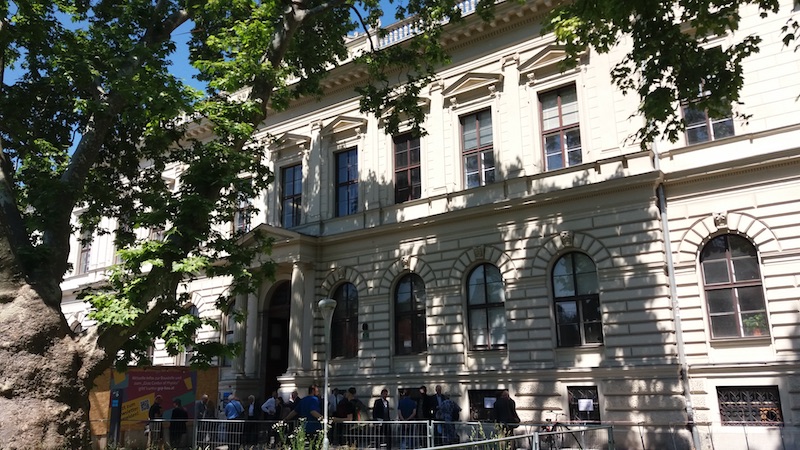
Front side of the institute of physics of the University of Graz - Image credit: Gina Gunaratnam/EPS
Authors: Sonja Draxler and Heinz Krenn
Following the decision on 16 November 2023, the building of the
Institute of Physics at the University of Graz has been honoured with
the distinction of an EPS Historic Site, an award of great importance for
achievements in physics and research. The nomination is the result of an
initiative by the First European Centre for the History of Physics
(ECHOPHYSICS, founded by Peter Maria Schuster).
In a festive
ceremony on 7th June 2024, a commemorative plaque was unveiled by Mairi
Sakellariadou, President of EPS, and Peter Riedler, Rector of Graz
University, on the facade of the physics building at Universitätsplatz
5 in Graz.
The celebration was embedded in a symposium on the historical
construction of the physics building and its leading figure Ludwig
Boltzmann. It was a special honour for us that a great-grandson of Ludwig
Boltzmann, Dieter Fasol, also participated in the symposium and gave a
lecture on “Ludwig Boltzmann, Ilse M. Fasol-Boltzmann and Artificial
Intelligence”.
The physics institute was built between 1872-1876 under the supervision of the physicist August Toepler and
was considered one of the most modern physics research centres at the
time. What was so special about this building? Sun ray corridors running
through the entire ground floor of the building enabled optical
experiments to be carried out in all rooms using heliostats. At the back
side of the building iron-free rooms for galvanometric measurements
were established, and an astronomical observatory was attached to the
building.
August Toepler himself unfortunately could not use this
modern building for his studies as he was appointed to the Royal Saxon
Polytechnic in Dresden and left Graz in 1876. Ludwig Boltzmann was
appointed as his successor. In 1876 he moved into the new institute
building in his second professorship in Graz as full professor of
general and experimental physics.
Besides Ludwig Boltzmann, a
number of other renowned physicists worked, researched and taught in
this building: August Toepler, Albert von Ettingshausen, Walther Nernst,
Svante Arrhenius, Alfred and Kurt Wegener, Viktor F. Hess, Erwin
Schrödinger, Adolf Smekal, Hans Benndorf, Paul Urban, Otto Burkard,
Wilhelm Nordberg, Günther Porod.

Floor plan from the building according to designs by August Toepler - Image credit: W. Höflechner, Archiv der Univ. Graz, post-processed by H. Krenn

Physics Lecture Hall in 1913 - Image credit: K. Rumpf, Publications of the Archive Univ. Graz, vol. 40, post-processed by H. Krenn

Unveiling the memorial plaque by EPS President Mairi Sakellariadou and Rector Peter Riedler on 7th June 2024
Image credit: K. Tzivanopoulos, Univ. Graz, Communications and Public Affairs